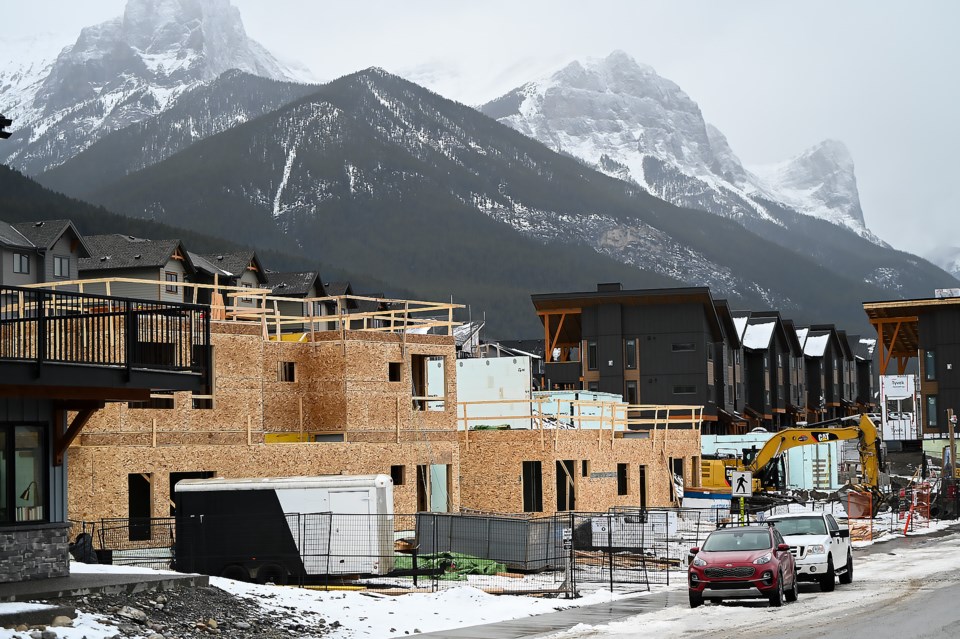CANMORE – An ask for the Alberta government to complete a new environment assessment of the Three Sisters Mountain Village projects will not go ahead after the province ruled it didn’t have the jurisdiction.
In a Wednesday (Feb. 28) letter to TSMVPL, Bow Valley Engage and Stoney Nakoda First Nation, the province found the approved Three Sisters Village and Smith Creek area structure plans (ASPs) align with the Natural Resources Conservation Board (NRCB) 1992 ruling.
“I find that the current Three Sisters project and its ongoing construction are a continuation of the overall tourism and recreational project that was applied for and approved by the [NRCB] in 1992,” stated Corinne Kristensen, the director of regulatory assurance section for the Environment and Protected Areas ministry, in a letter.
“As such, I am of the opinion that I lack jurisdiction to determine whether an environmental assessment of the project is warranted at this time.”
Though stating the ministry lacked jurisdiction, Kristensen said if new or different became available she could review the decision.
The request for a new environmental assessment was made first by Bow Valley Engage, a citizens group located largely in Canmore, followed by the Îyârhe (Stoney) Nakoda First Nation. The two groups had claimed the most recent environmental assessment was outdated by more than three decades and needed a new review.
Bow Valley Engage first made its request Jan. 9 and Stoney Nakoda First Nation followed suit on Feb. 7. TSMVPL also provided letters on Jan. 24 and Feb. 9.
“The concerns expressed in the letters surrounding this project are broad, and include issues related to the size, scope and environmental and community impacts from the development during construction and once fully constructed under the Smith Creek and Three Sisters [Village] area structure plans,” wrote Kristensen.
Karsten Heuer, a wildlife biologist and president of Bow Valley Engage, said they’re considering their next steps as an organization but “there is case law suggesting the province does have jurisdiction. There is too much at stake for our wildlife and our community to simply accept this decision.”
A campaign to request the environmental assessment generated 961 letters to provincial representatives.
“It's ironic that the same government that overturned our community's rejection of these developments is saying it has no jurisdiction to assess them for the harm they could cause.,” Heuer said.
“Our provincial government hasn't been shy about meddling in local affairs to protect rich landowner's interests but they're absent when it comes to protecting the public's interest. They're hiding behind an outdated assessment done for a very different project and environmental conditions 32 years ago. It's irresponsible behaviour. The world has changed. BVE is considering its options.”
The Outlook reached out to representation from Stoney Nakoda First Nation, but wasn’t immediately available. The story will be updated when the Outlook hears back.
In their legal argument, Bow Valley Engage had stressed the region is “an environmentally significant area and unique within the province of Alberta,” and its importance as a wildlife corridor between Kananaskis Country and Banff National Park.
The Stoney Nakoda First Nation argued there had been “no consideration given to the potential impacts of the project on Aboriginal peoples and their treaty rights,” as well as impacts to wildlife and the environment.
A representative from TSMVPL wasn’t immediately available, but in a Facebook post stated since the project wasn’t a proposed activity under the Environmental Protection and Enhancement Act a new EIA wasn’t needed.
TSMVPL has highlighted the lands have undergone an environmental impact assessment as part of the NRCB application in 1992, but also done environmental, biophysical, wildlife and other assessments which have also been reviewed by independent third parties.
“TSMV is proud of the work we have done on wildlife corridors and human wildlife conflict and we will continue to work with the province to monitor wildlife and adapt our proposed mitigations in alignment with our 2020 EIS work,” stated TSMV’s Facebook post. “There’s still more work to do to improve wildlife corridors and how they function today, particularly in human use management. It was clear from the data and work undertaken with respect to human use management by the province, Town of Canmore and others, that addressing human use of the corridors is a priority. Working together we will ensure that wildlife continues to move through the Bow Valley by clearly delineating spaces for people and spaces for wildlife”
The Smith Creek and Three Sisters Village ASPs had environmental impact studies completed in 2020, which was reviewed by the province, the Town of Canmore and an independent third party hired by the Town.
TSMVPL had originally applied for a wildlife corridor in 2017, but it was ultimately denied by Alberta Environment and Parks in 2018. The same ministry approved a modified application in 2020, which featured a realignment of the Across Valley Corridor and a wildlife crossing under the Trans-Canada Highway.
Canmore council adopted the ASPs last October after the Court of Appeal upheld the Land and Property Rights Tribunals (LPRT) decisions from 2022.
The adoption of the ASPs were as originally submitted for council consideration in 2021.
The Town and TSMVPL will work through infrastructure and planning in 2024 and into 2025, but construction is anticipated to begin as early as 2025.
The Smith Creek ASP would see an estimated population of 2,200 to 4,500 people and includes about 1,000 and 2,150 residential units. The ASP includes upwards of 75,000-square-feet of light industrial and business space and roughly 125,000-square-feet of retail and commercial space for local services.
The Three Sisters Village ASP could have between 3,000-5,000 residential units – which would depend on the bonus density element – and between 5,500-10,000 visitors and permanent population. It would include up to 602,000-square-feet of retail and business space and about 190,000-square-feet of indoor recreation and entertainment, with 75 hectares of open space and 10 per cent of affordable housing.




